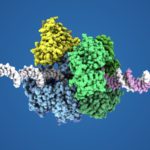Lien DOI – 10.3389/fmicb.2023.1204045
Volume 14
TsaC/Sua5 family of enzymes catalyzes the first step in the synthesis of N6-threonylcarbamoyl adenosine (t6
A) one of few truly ubiquitous tRNA modifications important
for translation accuracy. TsaC is a single domain protein while Sua5 proteins contains
a TsaC-like domain and an additional SUA5 domain of unknown function. The
emergence of these two proteins and their respective mechanisms for t6
A synthesis
remain poorly understood. Here, we performed phylogenetic and comparative
sequence and structure analysis of TsaC and Sua5 proteins. We confirm that this
family is ubiquitous but the co-occurrence of both variants in the same organism
is rare and unstable. We further find that obligate symbionts are the only organisms
lacking sua5 or tsaC genes. The data suggest that Sua5 was the ancestral version of
the enzyme while TsaC arose via loss of the SUA5 domain that occurred multiple
times in course of evolution. Multiple losses of one of the two variants in combination
with horizontal gene transfers along a large range of phylogenetic distances explains
the present day patchy distribution of Sua5 and TsaC. The loss of the SUA5 domain
triggered adaptive mutations affecting the substrate binding in TsaC proteins. Finally,
we identified atypical Sua5 proteins in Archaeoglobi archaea that seem to be in the
process of losing the SUA5 domain through progressive gene erosion. Together,
our study uncovers the evolutionary path for emergence of these homologous
isofunctional enzymes and lays the groundwork for future experimental studies on
the function of TsaC/Sua5 proteins in maintaining faithful translation.

